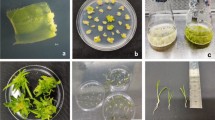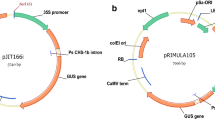Abstract
Lolium temulentum L. (Darnel ryegrass) has been proposed to be used as a model species for functional genomics studies in forage and turf grasses, because it is a self-fertile, diploid species with a short life cycle and is closely related to other grasses. Embryogenic calluses were induced from mature embryos of a double haploid line developed through anther culture. The calluses were broken up into small pieces and used for Agrobacterium tumefaciens-mediated transformation. A. tumefaciens strain EHA105 harboring pCAMBIA1301 and pCAMBIA1305.2 vectors were used to infect embryogenic callus pieces. Hygromycin was used as a selection agent in stable transformation experiments. Hygromycin resistant calluses were obtained after 4–6 weeks of selection and transgenic plants were produced in 10–13 weeks after Agrobacterium-mediated transformation. Fertile plants were readily obtained after transferring the transgenics to the greenhouse. Transgenic nature of the regenerated plants was demonstrated by Polymerase chain reaction (PCR), Southern hybridization analysis, and GUS staining. Progeny analysis showed Mendelian inheritance of the transgenes. The transformation system provides a valuable tool for functionality tests of candidate genes in forage and turf grasses.





Similar content being viewed by others
Abbreviations
- 2,4-D:
-
2,4-Dichlorophenoxy acetic acid
- ESTs:
-
Expressed sequence tags
- PCR:
-
Polymerase chain reaction
References
Aldemita RR, Hodges TK (1996) Agrobacterium tumefaciens-mediated transformation of japonica and indica rice varieties. Planta 199:612–617
Altpeter F, Vasil V, Srivastava V, Stöger E, Vasil IK (1996) Accelerated production of transgenic wheat (Triticum aestivum L.) plants. Plant Cell Rep 16:12–17
Bajaj S, Ran Y, Phillips J, Kularajathevan G, Pal S, Cohen D, Elborough K, Puthigae S (2006) A high throughput Agrobacterium tumefaciens-mediated transformation method for functional genomics of perennial ryegrass (Lolium perenne L.). Plant Cell Rep 25:651–659
Boss PK, Bastow RM, Mylne JS, Dean C (2004) Multiple pathways in the decision to flower: enabling, promoting, and resetting. Plant Cell 16:S18–31
Cairns AJ, Bonnett GD, Gallagher JA, Simpson RJ, Pollock CJ (1997) Fructan biosynthesis in excised leaves of Lolium temulentum. VII. Sucrose and fructan hydrolysis by a fructan-polymerizing enzyme preparation. New Phytol 136:61–72
Chen L, Auh C, Dowling P, Bell J, Chen F, Hopkins A, Dixon RA, Wang Z-Y (2003) Improved forage digestibility of tall fescue (Festuca arundinacea) by transgenic down-regulation of cinnamyl alcohol dehydrogenase. Plant Biotechnol J 1:437–449
Chen L, Auh C, Dowling P, Bell J, Lehmann D, Wang Z-Y (2004) Transgenic down-regulation of caffeic acid O-methyltransferase (COMT) led to improved digestibility in tall fescue (Festuca arundinacea). Funct Plant Biol 31:235–245
Cheng X-F, Wang Z-Y (2005) Overexpression of COL9, a CONSTANS-LIKE gene, delays flowering by reducing CO and FT expression in Arabidopsis thaliana. Plant J 43:758–768
Chilton MD, Currier TC, Farrand SK, Bendich AJ, Gordon MP, Nester EW (1974) Agrobacterium tumefaciens DNA and PS8 bacteriophage DNA not detected in crown gall tumors. Proc Natl Acad Sci USA 71:3672–3676
Dalton SJ, Bettany AJE, Timms E, Morris P (1999) Co-transformed, diploid Lolium perenne (Perennial ryegrass), Lolium multiflorum (Italian ryegrass) and Lolium temulentum (Darnel) plants produced by microprojectile bombardment. Plant Cell Rep 18:721–726
Dong S, Qu R (2005) High efficiency transformation of tall fescue with Agrobacterium tumefaciens. Plant Sci 168:1453–1458
Evans LT (1958) Lolium temulentum L., a long-day plant requiring only one inductive photocycle. Nature 182:197–198
Evans LT (1964) Inflorescence initiation in Lolium temulentum L. V. The role of auxins and gibberellins. Aust J Biol Sci 17:10–23
Evans LT (1999) Gibberellins and flowering in long day plants, with special reference to Lolium temulentum. Aust J Plant Physiol 26:1–8
Evans LT, King RW (1985) Lolium temulentum. In: Halevy AH (ed) CRC handbook of flowering. CRC, Boca Raton, pp 306–323
Evans LT, Wardlaw IF (1966) Independent translocation of 14C-labelled assimilates and of the floral stimulus in Lolium temulentum. Planta 68:319–326
Frame BR, Shou H, Chikwamba RK, Zhang Z, Xiang C, Fonger TM, Pegg SEK, Li B, Nettleton DS, Pei D, Wang K (2002) Agrobacterium tumefaciens-mediated transformation of maize embryos using a standard binary vector system. Plant Physiol 129:13–22
Gallagher JA, Pollock CJ (1998) Isolation and characterization of a cDNA clone from Lolium temulentum L. encoding for a sucrose hydrolytic enzyme which shows alkaline/neutral invertase activity. J Exp Bot 49:789–795
Gocal GFW, King RW, Blundell CA, Schwartz OM, Andersen CH, Weigel D (2001) Evolution of floral meristem identity genes. Analysis of Lolium temulentum genes related to APETALA1 and LEAFY of Arabidopsis. Plant Physiol 125:1788–1801
Gocal GFW, Poole AT, Gubler F, Watts RJ, Blundell C, King RW (1999) Long-day up-regulation of a GAMYB gene during Lolium temulentum inflorescence formation. Plant Physiol 119:1271–1278
Hood EE, Gelvin SB, Melchers LS, Hoekema A (1993) New Agrobacterium helper plasmids for gene transfer to plants. Transgenic Res 2:208–218
Hu T, Metz S, Chay C, Zhou HP, Biest N, Chen G, Cheng M, Feng X, Radionenko M, Lu F, Fry J (2003) Agrobacterium-mediated large-scale transformation of wheat (Triticum aestivum L.) using glyphosate selection. Plant Cell Rep 21:1010–1019
Ishida Y, Saito H, Ohta S, Hiei Y, Komari T, Kumashiro T (1996) High efficiency transformation of maize (Zea mays L.) mediated by Agrobacterium tumefaciens. Nat Biotechnol 14:745–750
Jauhar PP (1993) Cytogenetics of the Festuca-Lolium complex: relevance to breeding. Springer, Berlin
King RW, Evans LT (2003) Gibberellins and flowering of grasses and cereals: prizing open the lid of the “florigen” black box. Annu Rev Plant Biol 54:307–328
King RW, Moritz T, Evans LT, Junttila O, Herlt AJ (2001) Long-day induction of flowering in Lolium temulentum involves sequential increases in specific gibberellins at the shoot apex. Plant Physiol 127:624–632
Knox RB, Evans LT (1968) Inflorescence initiation in Lolium temulentum L. XII. An autoradiographic study of evocation in the shoot apex. Aust J Biol Sci 21:1083–1094
Lichtenstein C, Draper J (1985) Genetic engineering of plants. In: Glover DM (ed) DNA cloning. IRL Press, Oxford, pp 67–119
Mander LN, Sherburn M, Camp D, King RW, Evans LT, Pharis RP (1998) Effects of D-ring modified gibberellins on flowering and growth in Lolium temulentum. Phytochemistry 49:2195–2206
Mendel RR, Mueller B, Schulze J, Kolesnikov V, Zelenin A (1989) Delivery of foreign genes to intact barley cells by high-velocity microprojectiles. Theor Appl Genet 78:31–34
Mian R, Saha M, Hopkins A, Wang Z-Y (2005) Use of tall fescue EST-SSR markers in phylogenetic analysis of cool-season forage grasses. Genome 48:637–647
Murashige T, Skoog F (1962) A revised medium for rapid growth and bioassays with tobacco tissue culture. Physiol Plant 15:473–497
Pellegrineschi A, McLean S, Salgado M, Velazquez L, Hernandez R, Brito RM, Noguera M, Medhurst A, Hoisington D (2001) Transgenic wheat plants: A powerful breeding source. Euphytica 119:133–136
Pharis RP, Evans LT, King RW, Mander LN (1987) Gibberellins, endogenous and applied, in relation to flower induction in the long-day plant Lolium temulentum. Plant Physiol 84:1132–1138
Sambrook J, Fritsch EF, Maniatis T (1989) Molecular cloning: A laboratory manual. Cold Spring Harbor Laboratory, New York
Spangenberg G, Wang Z-Y, Potrykus I (1998) Biotechnology in forage and turf grass improvement. Springer, Berlin
Spangenberg G, Wang Z-Y, Wu XL, Nagel J, Iglesias VA, Potrykus I (1995a) Transgenic tall fescue (Festuca arundinacea) and red fescue (F. rubra) plants from microprojectile bombardment of embryogenic suspension cells. J Plant Physiol 145:693–701
Spangenberg G, Wang Z-Y, Wu XL, Nagel J, Potrykus I (1995b) Transgenic perennial ryegrass (Lolium perenne) plants from microprojectile bombardment of embryogenic suspension cells. Plant Sci 108:209–217
Thomas H, Morgan WG, Thomas AM, Ougham HJ (1999) Expression of the stay-green character introgressed into Lolium temulentum Ceres from a senescence mutant of Festuca pratensis. Theor Appl Genet 99:92–99
Walker RP, Winters AL, Pollock CJ (1997) Purification and characterization of invertases from leaves of Lolium temulentum. New Phytol 135:259–266
Wan YC, Lemaux PG (1994) Generation of large numbers of independently transformed fertile barley plants. Plant Physiol 104:37–48
Wang Z-Y, Bell J, Ge YX, Lehmann D (2003a) Inheritance of transgenes in transgenic tall fescue (Festuca arundinacea Schreb.). In Vitro Cell Dev Biol Plant 39:277–282
Wang Z-Y, Bell J, Scott M (2003b) A vernalization protocol for obtaining progenies from regenerated and transgenic tall fescue (Festuca arundinacea Schreb.) plants. Plant Breed 122:536–538
Wang Z-Y, Ge Y (2005) Agrobacterium-mediated high efficiency transformation of tall fescue (Festuca arundinacea Schreb.). J Plant Physiol 162:103–113
Wang Z-Y, Ge Y (2006) Recent advances in genetic transformation of forage and turf grasses. In Vitro Cell Dev Biol Plant 42:1–18
Wang Z-Y, Ge Y, Mian R, Baker J (2005) Development of highly tissue culture responsive lines of Lolium temulentum by anther culture. Plant Sci 168:203–211
Wang Z-Y, Hopkins A, Scott M (2002) Plant regeneration from embryogenic cell suspension cultures of Lolium temulentum. In Vitro Cell Dev Biol Plant 38:446–450
Wang Z-Y, Takamizo T, Iglesias VA, Osusky M, Nagel J, Potrykus I, Spangenberg G (1992) Transgenic plants of tall fescue (Festuca arundinacea Schreb.) obtained by direct gene transfer to protoplasts. Bio Technol 10:691–696
Wang Z-Y, Valles MP, Montavon P, Potrykus I, Spangenberg G (1993) Fertile plant regeneration from protoplasts of meadow fescue (Festuca pratensis Huds.). Plant Cell Rep 12:95–100
Wang Z-Y, Ye XD, Nagel J, Potrykus I, Spangenberg G (2001) Expression of a sulphur-rich sunflower albumin gene in transgenic tall fescue (Festuca arundinacea Schreb.) plants. Plant Cell Rep 20:213–219
Xiao K, Zhang C, Harrison M, Wang Z-Y (2005) Isolation and characterization of a novel plant promoter that directs strong constitutive expression of transgenes in plants. Mol Breed 15:221–231
Ye X, Wang Z-Y, Wu X, Potrykus I, Spangenberg G (1997) Transgenic Italian ryegrass (Lolium multiflorum) plants frtile bombardment of embryogenic suspension cells. Plant Cell Rep 16:379–384
Zhang J, Xu RJ, Elliott MC, Chen DF (1997) Agrobacterium-mediated transformation of elite Indica and Japonica rice cultivars. Mol Biotechnol 8:223–231
Zhang L, Rybczynski JJ, Langenberg WG, Mitra A, French R (2000) An efficient wheat transformation procedure: transformed calli with long-term morphogenic potential for plant regeneration. Plant Cell Rep 19:241–250
Acknowledgements
The authors would like to thank Elane Wright and Tina Norton for critical reading of the manuscript. This work was supported by the Samuel Roberts Noble Foundation.
Author information
Authors and Affiliations
Corresponding author
Additional information
Communicated by G. D. May
Rights and permissions
About this article
Cite this article
Ge, Y., Cheng, X., Hopkins, A. et al. Generation of transgenic Lolium temulentum plants by Agrobacterium tumefaciens-mediated transformation. Plant Cell Rep 26, 783–789 (2007). https://doi.org/10.1007/s00299-006-0288-1
Received:
Revised:
Accepted:
Published:
Issue Date:
DOI: https://doi.org/10.1007/s00299-006-0288-1




